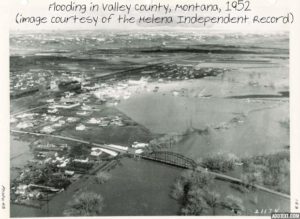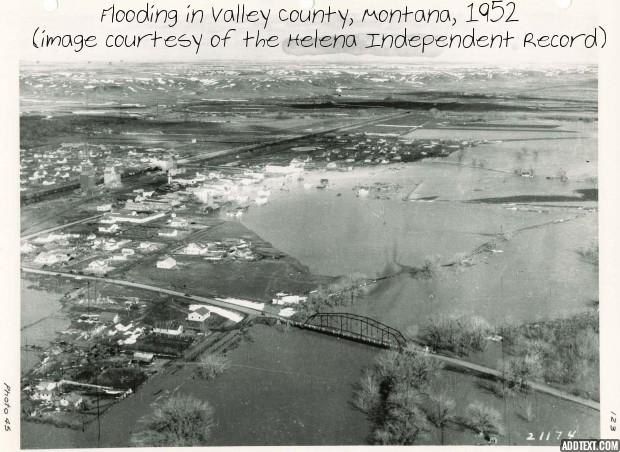 Although we are relieved to see the weather is warming, warmer temperatures can bring crazy weather and related flooding events. The National Oceanic and Atmospheric Administration’s (NOAA) Spring Flood Risk prediction is generally low for Montana, but IT IS ALWAYS GOOD TO BE PREPARED! We hope this article gives you some helpful tools as we enter into the uncertainties and excitements of “springtime in the Rockies”!
Although we are relieved to see the weather is warming, warmer temperatures can bring crazy weather and related flooding events. The National Oceanic and Atmospheric Administration’s (NOAA) Spring Flood Risk prediction is generally low for Montana, but IT IS ALWAYS GOOD TO BE PREPARED! We hope this article gives you some helpful tools as we enter into the uncertainties and excitements of “springtime in the Rockies”!
NOAA Spring Flood Risk Prediction
The following are few highlights from NOAA’s March 16, 2017 National Hydrologic Assessment (read the full report here):
- “A heavy mountain snowpack leads to the threat of minor flooding along some tributaries to the Milk and Yellowstone Rivers in Montana and in the Wind River Basin in Wyoming.”
- “Many rivers located in the northern plains of the Missouri River basin are expected to exceed minor flooding due to a combination of a considerable plains snowpack in North Dakota and wet soils in Montana…[i]n the mountainous west, minor flooding is expected along some tributaries to the Milk and Yellowstone, such as the Sun River, Clear Creek, and Clarks Fork Yellowstone River in Montana, and in the Wind River Basin in Wyoming.
- “Snowpack in the Pacific Northwest is well above normal in the Cascades in Oregon and the Rocky Mountains from southern Idaho to northwest Wyoming, while snowpack is near or slightly below normal in the Cascades of Washington and the Rocky Mountains in northern Idaho and western Montana.”
Things to Remember BEFORE a Flood
- Know the Facts about FLOOD INSURANCE
- Flood insurance is available to anyone in the community as long as the community is participating in the National Flood Insurance Program (NFIP) – not just to those living in high-risk flood zones.
- There is a 30-day waiting period for most flood insurance policies to go into effect. Therefore, folks worried about flooding should consider purchasing flood insurance as soon as possible.
- Flood insurance can assist with damages caused by surface waters from any source, as long as the damage affects at least two properties or two acres of land. This can include flood damage on a private property and neighboring county road, for example.
- Property owners who have flood insurance can be reimbursed up to $1,000 for the removal of insured property to a safe location and $1,000 for preventive measures for buildings in imminent danger of being flooded (e.g. purchasing sand bags or pumps).
- A disaster declaration by the President is not required to make a flood claim.
- Click here for information on flood insurance in Montana.
- Get EMERGENCY ALERTS on your smartphone
- The Montana All-Hazards Weather Monitor website offers up-to-date information on stream flows and potential flood conditions.
- Know how to contact your County Disaster & Emergency Services (DES) Coordinator: MT DES Coordinator Directory
Things to Remember DURING a Flood
- STAY INFORMED by monitoring local radio and television
- Turn Around Don’t Drown
- Practice ELECTRICAL SAFETY – Don’t go into a basement, or any room, if water covers the electrical outlets or if cords are submerged. If you see sparks or hear buzzing, crackling, snapping or popping noises –get out! Stay out of water that may have electricity in it!
Things to Remember AFTER a Flood
- DOCUMENT FLOOD DAMAGE – It is essential to document any flood-related occurrence. Document the event and costs associated with your activities and, whenever possible, take photos of any flooding or flood damages.
- Encourage business and private property owners to document their damages.
- Ensure that Public Works, Road Departments, and DES folks are documenting their flood preparedness and response activities.
- EMERGENCY PERMITTING PROCEDURES – We know that during a disaster, people’s lives are at stake and you must act quickly. However, be sure to follow up with your local Floodplain Administrator (Floodplain Administrator Directory) so that local rules and procedures are followed.
- DISASTER DECLARATION – If a Presidential Disaster is declared, it is essential to have close coordination between FEMA, public works personnel and your engineering or architectural consultant to develop ACCURATE DAMAGE COST ESTIMATES. It is much easier to calculate costs correctly the first time than try to convince FEMA to adjust them at a later date!
Other Helpful Links
Article written by Jonathan Weaver, PE, CFM

